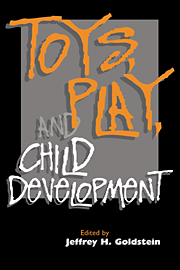Book contents
- Frontmatter
- Contents
- Acknowledgments
- List of contributors
- Introduction
- 1 Imaginative play and adaptive development
- 2 Play, toys, and language
- 3 Educational toys, creative toys
- 4 The war play debate
- 5 War toys and aggressive play scenes
- 6 Sex differences in toy play and use of video games
- 7 Does play prepare the future?
- 8 Play as healing
- References
- Name index
- Subject index
2 - Play, toys, and language
Published online by Cambridge University Press: 07 October 2009
- Frontmatter
- Contents
- Acknowledgments
- List of contributors
- Introduction
- 1 Imaginative play and adaptive development
- 2 Play, toys, and language
- 3 Educational toys, creative toys
- 4 The war play debate
- 5 War toys and aggressive play scenes
- 6 Sex differences in toy play and use of video games
- 7 Does play prepare the future?
- 8 Play as healing
- References
- Name index
- Subject index
Summary
The language that children use when they play with toys is interesting to parents, teachers, and researchers. At one level, each of these groups is interested in the play and language children use with specific toys. For example, parents and teachers may choose specific toys for their children to play with because of the types of play and language that they think the toys will elicit. Specific toys may be purchased because of their potential educational value. Similarly, researchers often examine the effects of specific toys, such as war toys, on children's play (see Sutton-Smith, 1992 and this volume, and Smith et al., 1992 and this volume). These views of the effects of toys generally take the position that the toys themselves elicit the play and language that are observed. In the language of ecological psychologists like Barker and Wright (1955) and Gump (1989), the environment, of which toys are part, “coerces” behaviors from individuals; children, from this perspective, have minimal influence on the environment.
A contrasting view, dating back at least to Kurt Lewin (1954) and more recently to Bronfenbrenner (1979), conceptualizes the environment and toys more specifically in transactional terms. By transaction we mean that children and toys influence each other. The ways in which children interact with specific toys vary according to features of the children themselves, such as temperament, gender, and age, and of the toys themselves; the toys do not elicit the behavior independently of characteristics of the child.
- Type
- Chapter
- Information
- Toys, Play, and Child Development , pp. 27 - 45Publisher: Cambridge University PressPrint publication year: 1994
- 5
- Cited by

